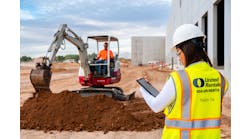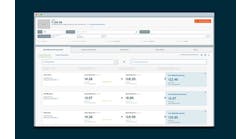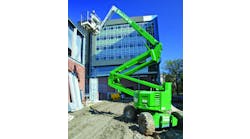Telematics, by design, give brains to construction equipment. Intelligence is engineered into the engine and operating systems to make the equipment perform better and live longer. While not quite comparable to 2001: A Space Odyssey's HAL-9000 supercomputer, telematics-equipped construction machines can be armed with the intelligence to know where they are, where they're supposed to be and what they're doing. These machines know when their oil is low, when their engine is running hot and when their gas tank is almost empty. They know when the engine is on when it should be off, and when the machine is idling when it could instead be shut down.
Telematics enable a rental machine to protect itself from abuse and optimize performance for as long as it is part of a rental fleet. Telematics watch that equipment very carefully, monitoring it for the moment when it's time to notify the owner or operator that the machine needs intervention — whether it be for a required maintenance point, the breach of a geofence that trips an alarm, or evidence that the machine was used after it was called off-rent, arming the rental company with the data it needs to correctly bill the client for all the time used. The added intelligence that telematics systems provide can help rental companies achieve significant savings and fast return on investment.
These telematics technologies are not brand new, but they are more widely available than ever before and also more easily integrated with most of today's rental management and other software systems. In addition, telematics are able to monitor more parameters and diagnose more machine issues than ever before. What once was a very expensive aftermarket technology is today more commonly found as a factory-installed option, particularly on big-ticket fleet items. And, to make it easier, OEMs such as Komatsu, John Deere, Hitachi, JLG, JCB, Volvo and Caterpillar are getting into the mix, offering onboard tele-matics systems to their latest product offerings and seeking out partnerships with telematics specialists such as Qualcomm, MasterTrak and others to achieve seamless back-office reporting and systems monitoring.
Why telematics?
One of the most obvious reasons to embrace telematics now is because of the added scrutiny with which a fleet owner will look at his or her equipment with telematics devices in place. These systems bring to light many ways to improve machine efficiency, whether it's lowered fuel consumption, improved maintenance schedules or additional revenue captured on rent. There is something to be gained from their use.
Based on the input from most of the telematics and software providers interviewed by RER for this article, the rental industry has been slower to adopt the technology than anticipated, although adoption and interest has increased significantly in the past year or two. Historically, the high cost of purchasing and monthly monitoring of telematic data made the technology cost prohibitive for some rental companies, but over time costs have begun to decline and the technology has grown in sophistication.
“Rental customers want to maximize rental incomes and minimize owning costs,” says Ken Calvert, director IT support, Komatsu America Corp. “Telematics help progressive rental companies identify under-utilized assets and better time maintenance and repairs. Smart, progressive companies seize competitive advantages that lower their costs and their customers' costs. Creative application of telematic data is representative of such behavior. For these companies win-win is not a cliché.”
According to Alexander Schuessler, chairman and CEO of SmartEquip, telematics data takes on additional significance and value when paired with other types of machine data.
“Telematics data alone does not necessarily accomplish much,” says Schuessler. “However, when tied to preventive maintenance management, when attached to safety recalls, and when providing intelligent machine-centric information, rental companies can significantly improve fleet utilization and extend the life of their fleets. In practice this means they can either squeeze more rental revenues out of their existing fleet, or they can maintain their existing revenues while reducing fleet size.”
To capitalize on this value, SmartEquip works to tie telematics information directly to the OEM-sponsored maintenance, repair and operations information, processing the data in real time to maximize the equipment owner's investment on every asset.
“I would say that we have moved beyond the early adopters and are getting into the mainstream adopter phase for telematics technologies,” says Paul Chapdelaine, president, RMI Corp. “As prices continue to drop and functionality continues to increase, I expect that we will see a large mainstream population adopting this type of technology. Over time, telematics technologies will become the norm within the rental and construction industries. When this happens you will see solutions and pricing that are attractive to the latent adopters.”
According to Point-of-Rental Systems' president Bob Shaffer, it's the type and value of equipment a rental company owns that makes using telematics a good business decision. “Any rental company renting serialized inventory that costs more than $10,000 per unit should be investigating the advantages of using this technology,” he says.
Let's think outside the transmitter box for a minute. Today's telematics devices can do much more than monitor engine hours, fluid levels and geofence parameters. They can also provide valuable operating and maintenance records that can significantly improve resale values when the time comes to dispose of an asset from a rental fleet.
Telematics data can effectively be used to bill more accurately and improve overall fleet utilization. Cost savings can also be realized by applying telematics data to achieve fuel savings by eliminating equipment idle times and dispatching the closest service personnel in the area when jobsite maintenance is required.
“Right now fuel costs are a hot issue and contractors who rent machines with robust telematic systems such as Komatsu's Komtrax system are learning that using telematic information to control engine idle time and operating modes can reduce fuel burn by 10 to 25 percent per day,” says Calvert. “For a 20-ton excavator this translates to hundreds of dollars per month in avoided fuel costs. And reduced fuel burn is good for the environment.”
RMI's Advantage Software links with Qualcomm's GlobalTRACS equipment management system to determine whether or not excess usage has occurred and, if so, how much to invoice the customer for the excess usage. Rentalresult's Helen Sowerby also notes that capturing off-rent machine usage is a significant benefit to employing telematics systems.
“Telematics remove your dependence on user input — either clients logging their own usage, or your rental business correctly gathering the information on on- and off-rent,” says Sowerby, senior vice president business development, Result Group. “This is particularly useful for managing overtime hours and overtime charging.”
MasterTrak's end-to-end solution uses on-board machine electronic control units to provide access to hundreds of machine parameters that provide business value to rental companies and their customers, and those ECUs will increase even more as machines that meet the 2010 emissions requirements are rolled out, according to Gregg Johnson, president of MasterTrak.
Using OEM pilot/production programs, MasterTrak has been able to achieve substantial savings from the use of telematics for its OEM constituents, which include dealers, service providers, end users and rental companies. Remote diagnostics by the MasterTrak system have demonstrated savings in five areas: reduced breakdowns; improved preventive maintenance scheduling based on usage; improved vehicle utilization rates; reduced repair costs; and improved technician productivity.
“Rental companies that have a ‘connected fleet’ will realize lower annual operating/maintenance expenses, ‘guaranteed’ available uptime (greater revenue per asset) and higher asset residual value,” says Johnson.
Integration
Both OEMs as well as software providers acknowledge the benefits of telematics, and many have come together to develop solutions for fleet owners that can easily integrate with existing rental management and other back-office software systems in place. Most rental businesses support more than one make and model of construction equipment, making it imperative for OEMs and software developers to work together to create multi-vendor solutions for multi-line fleet owners.
Although many manufacturers are adding their own telematics systems, much of the equipment manufactured today is still sold without factory-installed telematics, making aftermarket solutions necessary for fleet owners who wish to take advantage of them. Additionally, different types of equipment require different types of connectivity. For example, indoor equipment is better covered using CDMA/cell signal or RFID connectivity, and outdoor equipment is well served by satellite-based technology. For these reasons, the ability of telematics systems to integrate with existing back-office rental management, dispatch and parts and warranty solutions is critical. So how are technology providers working together to achieve this integration?
According to Solutions by Computer president Jack Shea, as long as the technologies on both sides of the integration are compatible, then integration is no great technological challenge. “In theory, there should be no limit to how many different applications a rental software developer can integrate as long as the system was developed with enough vision to provide a robust foundation,” Shea explains.
As an example of an OEM-developed system, Komatsu's Komtrax data can be supplied as an XML for ease of integration into a rental company's enterprise systems. [XML stands for extensible markup language, which is a general-purpose specification that allows its users to define their own elements. Its primary purpose is to help information systems share structured data, particularly via the Internet and it is used both to encode documents and to serialize data.] MasterTrak's scalable, flexible design is engineered to integrate with virtually any ERP system and to integrate information from other telematics systems as well. RMI's Advantage Software is designed to be a multi-vendor solution so that it can support the needs of a multi-line dealership.
In June, Qualcomm announced that its GlobalTRACS telematics solution is now available exclusively through OEMs and equipment dealers. The company says its new service model will provide more end users with access to the benefits of its telematics data.
Rentalresult provides an Open Web Service for use with modern telematics solutions, which currently supports devices from Qualcomm, Caterpillar and Volvo Construction Equipment among others.
In its most recent revision, Point-of-Rental Systems' Enterprise software introduced an interface for Qualcomm's GlobalTRACS solution, according to president Bob Shaffer.
Other Qualcomm-integrated software partners, according to Qualcomm Enterprise Services director of OEM business development Bud Sims, include Wynne Systems, Genisys Software, Alert-IMS, RMI Advantage, Dispatching Solutions, SmartEquip and many others.
“We will never get to a point where a rental fleet will use a single telematics solution: different OEMs use different providers; some telematics solutions lend themselves to aftermarket retrofitting while others do not, which further reduces the rental company's ability to standardize on one solution,” says SmartEquip's Schuessler. “SmartEquip technology is utterly neutral, allowing for any type of telematics data stream to populate our applications, while also providing rental fleet owners a consolidated view of all their telematics data, regardless of the devices in use. What we are beginning to see now — and where I see the future of telematics going — is in OEM-sponsored initiatives involving companies such as JLG, Wacker and John Deere. Increasingly, as leading manufacturers take direct control over their customers' cost of fleet ownership, telematics and its bundled technology will play a very important part.”
JLG's ClearSky: Saving Resources
While generic telematics solutions are growing in popularity and availability, and a growing number of rental companies are acquiring telematic systems as add-ons to help manage their fleet and prevent theft, increasingly manufacturers are developing their own systems as value-added features for their dealers, rental companies and end users.
JLG, together with MasterTrak which supplies the system, created ClearSky, the first “connected asset” system customized for aerial work platform rental fleets, JLG says. ClearSky is designed for dealers and rental companies to remotely track the physical location of their units as well as real-time looks at hours of usage and an array of indicators regarding machine performance. The system is designed to help fleet owners manage their maintenance and service costs more efficiently and increase rental revenue.
ClearSky enables remote tracking of hours of usage; machine diagnostics including fuel consumption, engine oil pressure, engine temperature and real-time faults and alarms; machine operation status; engine hours and about 800 other variables that the equipment owner can customize or select according to his or her needs. It can send an alert when machines are nearing maintenance intervals, and can provide geo-fence theft notification, reports and charts of machine usage and faults incurred, GPS tracking and mapping location of machines in operation. The system essentially communicates information two ways: it can send information back to the owners' system on a periodic basis to report information on whatever data the owner seeks, or the owning company can proactively ping the machine.
JLG supplies a factory-installed control unit on each piece of equipment that utilizes ClearSky. The unit communicates directly with the engine and other relevant data points. Using a GPS antenna, the control unit communicates the machine's location via satellite, transmitting machine data through existing cell phone infrastructures. All information is tracked and updates are sent wirelessly to a pager, cell phone or e-mail, the communication coming in the form the company prefers. The company can set parameters to determine when updates should be sent.
“You may see something in an alarm state and maybe that alarm information came in 15 minutes ago, so you can proactively ping the unit to get up-to-the-minute information,” says Scott Milligan, JLG's director of inside sales and service. The mess-ages coming from the unit are color-coded. If the color indicates a fault code, it may be something the fleet owner wants to monitor but doesn't immediately see as critical.
For example, a unit has violated a geofence parameter that indicates the machine is a block or two away. The rental company may know the customer has another jobsite two blocks away, and while the rental contract doesn't allow for it to be used at the second site, the rental company may note the information but not consider it urgent enough to confront the customer at that exact moment. However, the owner may choose to ping the machine 15 minutes later — if he then sees that the machine is no longer two blocks away but is speeding down the Interstate at 70 miles an hour, immediate action may be called for.
In addition to being able to track the physical location of a unit, the system has a function called “breadcrumbing” that tracks the machine's previous 10 positions, enabling the administrator to determine over a period of time if the machine was utilized in a manner contrary to the rental agreement.
The same scenario might occur if a fault code indicates elevated engine temperature or any other operating concern. Service personnel can monitor to see if there's an ongoing issue and how urgent it is before making the decision to send out a service technician.
The ability to diagnose machines remotely is one of the most important values to a rental company. “If a customer calls in and says, ‘I'm having a problem with a machine,’ the rental company might send someone with an analyzer and plug it into the machine,” says Milligan. “It will give the same information we can get remotely, but the problem is you are sending someone out there to plug in that analyzer. That person may be the right person to fix that problem, or he may not be. He may have the right equipment with him to fix the problem or he may not. But with that information available before I send someone, you know if you're sending the right person, if he's bringing the right tools or if you even have to send someone. What does it cost for a service call? $25? $100? Different rental companies will value it differently, but whatever it costs, think about what you save if you know what needs to be done in advance.”
As Milligan explains, the service manager can look at the diagnosis and determine that the problem is relatively minor, and a rookie maintenance technician can easily take care of it. Or he may know in advance that a problem is fairly complex, requiring a more experienced and specialized technician. “You certainly don't want an experienced guy who's costing you more to go out to a remote site to fix a minor problem,” he says. “And you don't want an inexperienced guy to go there and call in saying ‘I can't fix this, I've never seen this before,’ so you have to send somebody else, wasting time and fuel by sending extra people. What we've tried to do is provide as much information as possible before you expend your maintenance resources — right mechanic, right skill level, right parts, no wasted time.”
An analysis of recent history can tip off a rental company before a machine breaks down. If a history of faults occurs over a couple of days, even though the machine is still running, the repeated alarms can give the company a clue that something is on the verge of becoming a major problem, enabling a proactive solution that could prevent a more serious issue from occurring. Also, a rental company can pre-load scheduled maintenance intervals that can alert the company when a maintenance procedure is due, even while the machine is on rent.
JLG plans to launch ClearSky on a global basis in the first quarter of 2009. It will be available as a factory install on new units or for recently manufactured units already in the field, ClearSky can be installed by dealerships or service personnel.
- Michael Roth
JCB's LiveLink: Digging Deeper
One of the largest manufacturers to come up with its own telematics program is JCB, whose LiveLink is designed to prevent theft, track location, diagnose equipment problems and a wide range of other telematic solutions. But JCB designed its system to go deeper into making a business more profitable.
“You don't want to overload the customer with data; you want to give the customer the right data,” says Chris Giorgianni, general manager product marketing for Pooler, Ga.-based JCB. “It's not just telling him where his machine is or if the engine's running or not, or if the machine is outside the geofence. It's also fuel consumption and other areas on how he can better utilize his asset, and how he can be more proactive on service.”
JCB views LiveLink as a tool that can help relationships between dealers and rental companies and their customers. “If I'm a dealer, I can call my customer and say, ‘You've got a machine that's within 20 hours of 500-hour service, I can go out and take care of it for you,’” says Giorgianni. “I know exactly where the machine is and I can take the machine down and put another in its place to minimize the effect on the customer's business.”
LiveLink is designed to monitor critical metrics such as engine temperature, transmission, hydraulic fuel, fuel consumption, vehicle wheel speed, engine speed and more. The ability for a rental company to monitor its assets thoroughly, receive timely message delivery by text message or e-mail if a unit is outside its geofence or curfew is a feature JCB customers find important as is the ability to receive over-the-Internet upgrades when applicable. LiveLink will be able to work on all makes and models and the company plans for factory installation for all customers beginning in the first quarter of 2009.
JCB developed LiveLink with Qualcomm, using Qualcomm's standard technology, although it took considerable engineering to get Qualcomm's technology to fit with JCB's. The user can access the information over the Internet, and therefore is not dependent on being at a company computer, but can access the information anywhere an Internet connection is available.
In its efforts to take the technology a step further in its evolution, JCB is working on developing new functionalities. “Let's look at breaker applications, for example,” says Giorgianni. “If the customer puts a breaker on the machine, we can tell exactly what hours the customer had a breaker on the excavator. So in the course of two weeks, five hours a week the customer had a breaker on the machine. So the customer can use that information to make an educated guess about whether or not he wants to keep that machine as a dedicated unit for that attachment, or maybe move that attachment around to extend fleet life. This is something we're looking at.”
Giorgianni says JCB's telematics philosophy is not to create a telematics system and then go onto a different project, but rather to continue to evolve it, just as it would evolve its backhoe loaders, telehandlers or excavators.
“We see it incumbent on ourselves to make this technology as simple as possible to operate,” he adds. “The simpler it is to utilize, the more apt people will be to use it. The technology has been around for some time, but now we see the customer coming to us, we're not forcing the technology on the customers.”
JCB launched LiveLink in Europe last spring, as a dealer-fit option with a limited number of features. JCB plans a worldwide launch in the first quarter of 2009. Machines built beginning in 2009 will be wired with the electrical harness to accept LiveLink and will be offered to JCB customers as a no-cost option.
JCB hopes to launch LiveLink in North America in the first quarter of 2009.
- Michael Roth
MicroLogic iSite: Stay Connected
When telematics were new on the scene users wanted first and foremost to know the location of their equipment and the number of hours logged on the engine. According to Marc Desrosiers, vice president in charge of sales for MicroLogic, the same is true today for about 90 percent of telematics customers. The difference is that now the numbers of metrics and machine health care points that can be monitored with telematics are nearly endless, and those two common metrics — engine hours and location — just scratch the surface of possibilities available.
MicroLogic offers a suite of satellite-based telematics systems called iSite designed for a number of equipment types, and largely serving the rental industry. CELogic meets the needs of off-road equipment; ServiceLogic serves on-road delivery, service and sales vehicles; and TrackerLogic is designed for general equipment GPS tracking.
“The system is designed to be simple,” Desrosiers says. “We're not intending for it to be another brick on someone's shoulder.”
The iSite integrated fleet management system uses a combination of bi-directional satellite communications systems and software to manage distributed assets. CELogic is well suited for equipment such as earthmovers, high-reach equipment, generators, pumps and ground-heating equipment. The basic model — 6000 — offers engine and auxiliary system run hours; GPS location; geographic and time fences; engine start/stop notification; and battery voltage notification. The more sophisticated 6500 offers up to eight additional digital sensor inputs on items such as low fuel, high engine temperature and low oil pressure. It also allows the user to schedule specific start-up and shut-down times for the equipment — a feature that can both help prevent theft and after-hours or off-rent use of the machine.
In addition, both the 6000 and 6500 models offer battery disconnect notification; standard reports such as overdue maintenance reports, status report; start/stop report; login report and second run time report; back office integration; and life-to-date history. For rental companies located in the northern United States and Canada that operate in harsh winter conditions, a battery voltage notification sensor can quickly let an operator know on a cold day if the battery is good, which can save a contractor from getting to a jobsite without a working battery.
The ServiceLogic product is designed for use on service, sales and delivery vehicles to track and record GPS location; vehicle mileage; speed and heading; geographical and time fencing; and engine idle time. It is even engineered to help support users with their International Fuel Tax Agreement reporting by tracking the number of miles traveled in the state per vehicle in the fleet.
Users benefit from tracked mileage for maintenance planning and also realize safety and productivity gains from more closely monitoring equipment usage. Costs are often reduced by minimizing or eliminating the number of unauthorized trips taken per vehicle as well.
The newest addition to the iSite lineup is TrackerLogic, which is designed to track equipment that doesn't have its own on-board power source. TrackerLogic can be removed and reassigned to another piece of equipment as often as necessary by the fleet owner. The device checks in three times per day using 100 percent satellite-based data to report its location anywhere in the world.
- Brandey Smith
Rental companies that have fleets of service vehicles, especially larger organizations, are becoming more dependent on some sort of fleet management system. ValuePlus Fleet Management, from Iowa Mold Tooling, is designed to help rental companies that own multiple service trucks by ensuring that the truck fleet is maintained, comparing fleet usage to that of other fleets, and collecting key data to verify that the trucks are being utilized as planned and that the operator time is being used wisely. The management system also is designed to provide true understanding of the cost of running a service fleet to improve operations and lower the cost. It can help determine the fleet's useful economic life in order to decide when it's time to cycle a vehicle out of the fleet, and effectively dispatch units to control fuel costs. ValuePlus Fleet Management is not limited to just IMT equipment or just to service trucks; it can be installed on any kind of equipment.
IMT ValuePlus Fleet Management: Keep Watchful
Rental companies using ValuePlus Fleet Management are able to reduce costs in a variety of ways. They can use reports to determine cost-per-hour on their service trucks to discover which trucks are the best performing and which are the lowest performing. Those reports can also be used to find out what the low cost-per-hour trucks are doing right that can be implemented fleet-wide.
The dispatching feature of ValuePlus Fleet Management is designed to keep fuel costs to a minimum by ensuring that the dispatcher sends the closest available truck to the jobsite. This function also greatly increases response time to the jobsite, improving customer satisfaction and ultimately helping the bottom line.
Vehicle location history, hours and mileage are designed to assist owners wanting to keep a watchful eye on where and when their equipment is being used. This software also allows a manager to view how fast his or her service trucks are traveling in real time. If an operator is speeding, a manager can call that person to tell them to slow down.
ValuePlus Fleet Management can also help rental companies get fuel tax credits. Fuel is only taxed for highway use, and the PTO reports ValuePlus generates help companies prove how much fuel was used off the road. The rental company can then file for fuel tax credits using those reports.
“Our software helps fleet managers reduce truck and fleet operating expenses, maximize vehicle utilization, and develop proper replacement cycles,” says Tim Worman, product manager of commercial vehicles for Iowa Mold Tooling. “That — coupled with the fuel tax credit — makes ValuePlus Fleet Management one of the best ways a rental company can confront rising fleet costs.”
- Katie Eagan Ernzen





